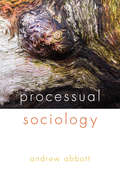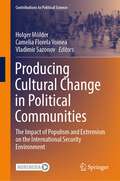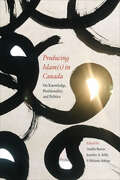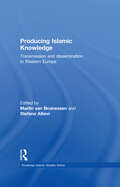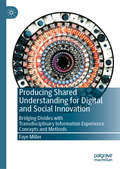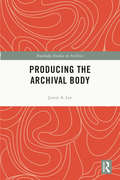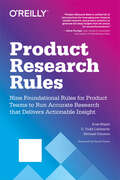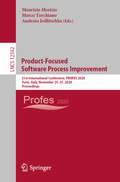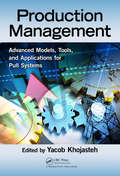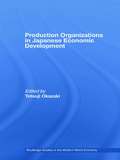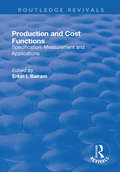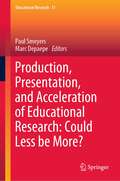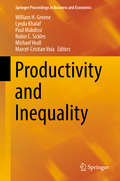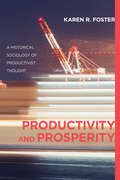- Table View
- List View
Processual Sociology
by Andrew AbbottFor the past twenty years, noted sociologist Andrew Abbott has been developing what he calls a processual ontology for social life. In this view, the social world is constantly changing--making, remaking, and unmaking itself, instant by instant. He argues that even the units of the social world--both individuals and entities--must be explained by these series of events rather than as enduring objects, fixed in time. This radical concept, which lies at the heart of the Chicago School of Sociology, provides a means for the disciplines of history and sociology to interact with and reflect on each other. In Processual Sociology, Abbott first examines the endurance of individuals and social groups through time and then goes on to consider the question of what this means for human nature. He looks at different approaches to the passing of social time and determination, all while examining the goal of social existence, weighing the concepts of individual outcome and social order. Abbott concludes by discussing core difficulties of the practice of social science as a moral activity, arguing that it is inescapably moral and therefore we must develop normative theories more sophisticated than our current naively political normativism. Ranging broadly across disciplines and methodologies, Processual Sociology breaks new ground in its search for conceptual foundations of a rigorously processual account of social life.
Producing Cultural Change in Political Communities: The Impact of Populism and Extremism on the International Security Environment (Contributions to Political Science)
by Camelia Florela Voinea Holger Mölder Vladimir SazonovIn light of many crises in the last two decades, including democratic recession, climate change, economic crises, and massive waves of migration affecting perceptions of security around the world, this book examines the impact of cultural change in political communities on the global political and security environment. Through various case studies of political communities around the world, the book analyzes contemporary responses to cultural change, often culminating in the rise of political populism and extremism. The book is divided into two parts and presents a foreword by Larry Diamond and an afterword by Eric Shiraev. The first part focuses on the micro-level of cultural change in political communities and discusses conflict mechanisms and the role of political participation in producing changes. The second part features studies on extremism and populism, analyzing their impact on cultural change in Europe. The book is intended for scholars and students in a variety of disciplines, including international relations, security studies, cultural studies, and related fields.
Producing Islam(s) in Canada: On Knowledge, Positionality, and Politics
by Melanie Adrian Jennifer A. Selby Amélie BarrasDuring the last twenty years, public interest in Islam and how Muslims express their religious identity in Western societies has grown exponentially. In parallel, the study of Islam in the Canadian academy has grown in a number of fields since the 1970s, reflecting a diverse range of scholarship, positionalities, and politics. Yet, academic research on Muslims in Canada has not been systematically assessed. In Producing Islam(s) in Canada, scholars from a wide range of disciplines come together to explore what is at stake regarding portrayals of Islam(s) and Muslims in academic scholarship. Given the centrality of representations of Canadian Muslims in current public policy and public imaginaries, which effects how all Canadians experience religious diversity, this analysis of knowledge production comes at a crucial time.
Producing Islamic Knowledge: Transmission and dissemination in Western Europe (Routledge Islamic Studies Series)
by Martin van Bruinessen Stefano AllieviHow do Muslims in Europe acquire discursive and practical knowledge of Islam? How are conceptions of Islamic beliefs, values and practices transmitted and how do they change? Who are the authorities on these issues that Muslims listen to? How do new Muslim discourses emerge in response to the European context? This book addresses the broader question of how Islamic knowledge (defined as what Muslims hold to be correct Islamic beliefs and practices) is being produced and reproduced in West European contexts by looking at specific settings, institutions and religious authorities. Chapters examine in depth four key areas relating to the production and reproduction of Islamic knowledge: authoritative answers in response to explicit questions in the form of fatwas. the mosque and mosque association as the setting of much formal and informal transmission of Islamic knowledge. the role of Muslim intellectuals in articulating alternative Muslim discourses. higher Islamic education in Europe and the training of imams and other religious functionaries. Featuring contributions from leading sociologists and anthropologists, the book presents the findings of empirical research in these issues from a range of European countries such as France, Italy, the Netherlands and Great Britain. As such it has a broad appeal, and will be of great interest to students and scholars of Islamic studies, anthropology, sociology and religion.
Producing Management Knowledge: Research as practice
by Jan Löwstedt Torbjörn StjernbergProviding readers with a unique insight into conducting research, this exciting book describes the thought and work processes of researchers as they complete their projects. Engaging and accessible it investigates all the key aspects of this topic and advice on how to conduct interviews, study the everyday life of an organization, and many other standard methods of conducting research. This is not a prescriptive methodology textbook, rather it explores how to approach, think and act in interaction with the empirical field. Comprehensive and accessible, this thought-provoking text shows readers how to develop management investigations skills, and will be invaluable for final year undergraduates, masters and PhD students.
Producing Shared Understanding for Digital and Social Innovation: Bridging Divides with Transdisciplinary Information Experience Concepts and Methods
by Faye MillerIn the Anthropocene age there is a need for unifying the relationships between people, planet and technology, their interactions, experiences and impacts across ecosystems. In response to this need, this book introduces unifying bridging concepts informational waves and transdisciplinary resonance towards producing shared understanding. This book also presents emerging methods for transdisciplinary projects focusing on moments, paradoxes and dialogues for digital social innovation and sustainable development partnership goals for improving quality of life. Shared understanding is about how people from different fields and perspectives are communicating, curating, embodying, intuiting and reflecting on shared responsibilities within social ecologies. As a guide to co-designing for information experiences that create meaningful moments of shared understanding, the author illuminates essential transferable, lateral mindsets and soft skills: knowing the gaps through imagination, creativity, listening and noticing, and bridging the gaps through problem emergence, multiple stakeholders, informed learning and personal change.
Producing Success: The Culture of Personal Advancement in an American High School
by Peter DemerathMiddle- and upper-middle-class students continue to outpace those from less privileged backgrounds. Most attempts to redress this inequality focus on the issue of access to financial resources, but as Producing Success makes clear, the problem goes beyond mere economics. In this eye-opening study, Peter Demerath examines a typical suburban American high school to explain how some students get ahead. Demerath undertook four years of research at a Midwestern high school to examine the mercilessly competitive culture that drives students to advance. Producing Success reveals the many ways the community's ideology of achievement plays out: students hone their work ethics and employ various strategies to succeed, from negotiating with teachers to cheating; parents relentlessly push their children while manipulating school policies to help them get ahead; and administrators aid high performers in myriad ways, even naming over forty students "valedictorians. " Yet, as Demerath shows, this unswerving commitment to individual advancement takes its toll, leading to student stress and fatigue, incivility and vandalism, and the alienation of the less successful. Insightful and candid, Producing Success is an often troubling account of the educationally and morally questionable results of the American culture of success.
Producing the Archival Body (Routledge Studies in Archives)
by Jamie A. LeeProducing the Archival Body draws on theoretical and practical research conducted within US and Canadian archives, along with critical and cultural theory, to examine the everyday lived experiences of archivists and records creators that are often overlooked during archival and media production. Expanding on the author’s previous work, which engaged archival and queer theories to develop the Queer/ed Archival Methodology that intervenes in traditional archival practices, the book invites readers interested in humanistic inquiry to re-consider how archives are defined, understood, deployed, and accessed to produce subjects. Arguing that archives and bodies are mutually constitutive and developing a keen focus on the body and embodiment alongside archival theory, the author introduces new understandings of archival bodies. Contributing to recent disciplinary moves that offer a more transdisciplinary emphasis, Lee interrogates how power circulates and is deployed in archival contexts in order to build critical understandings of how deeply archives influence and shape the production of knowledges and human subjectivities. Producing the Archival Body will be essential reading for academics and students engaged in the study of archival studies, library and information science, gender and women’s studies, anthropology, history, digital humanities, and media studies. It should also be of great interest to practitioners working in and with archives
Product Innovation Management: Intelligence, Discovery, Development (Management for Professionals)
by Stefano Biazzo Roberto FilippiniThis book offers new insights into the complex set of activities and decisions of product innovation management. It provides concepts, methods, and tools that can help accelerate the introduction of successful products to the market in an increasingly competitive and changing business landscape. It also offers examples and case studies, and it is the result of more than 20 years of study, research, and consulting carried out by the two authors in the field of innovation management. The book discusses the demanding challenges of product innovation and offers practitioners guidance on how to respond to these challenges. It presents a three-level framework (the “innovation pyramid”), which reflects the core components of a firm’s innovation capability: first, intelligence - absorbing information and knowledge from the outside world by looking beyond the familiar territories of the current market, technology, and customers; second, discovery - exploring opportunities for innovation through creative ideation and technology experimentation; and third, development - transforming opportunities into profitable new products and services.
Product Research Rules: Nine Foundational Rules For Product Teams To Run Accurate Research That Delivers Actionable Insight
by C. Todd Lombardo Michael Connors Aras BilgenDigital product research doesn't have to be difficult, take a long time, or cost a lot of money. Nor should it be a job solely for scientists or expert researchers. In this practical book, Aras Bilgen, C. Todd Lombardo, and Michael Connors demonstrate how your entire team can conduct effective product research within a couple of weeks--easily, cheaply, and without compromising quality.Drawing from decades of experience in product development, the authors lay out nine simple rules that combine user research, market research, and product analytics to quickly discover insights and build products customers truly need.Recognize and avoid common research pitfallsSwitch to the insight-making mindset that underlies all successful research effortsFind out how to look at data, formulate the right questions, and pick the right research methodLearn interview techniques and research skillsAnalyze for insights collaboratively while avoiding biasInspire action with your insights through powerful presentations and prototypesLearn how to involve a wide variety of stakeholders in research, from developers to executivesDiscover how you can make research a habit, not a one-off effort
Product Research: The Art and Science Behind Successful Product Launches
by John A. Cafeo N. R. RaghavanThis book is a collection of research papers to be presented at the GM R&D India Science Lab workshop on Art and Science of Product Development held at Bangalore, India. Leading researchers from around the world, and from within GM, present some of their latest research and experience around methodologies and analytics that we believe, are very critical to any product development activity. This book has articles in four major pillars of product development research: a, uncertainty modeling and information integration; b, role of behavioral research in understanding customer requirements and designing products; c, advanced analytical approaches for identifying voice of the customer; and d, human centered decision making and its role in product development.
Product-Focused Software Process Improvement: 21st International Conference, PROFES 2020, Turin, Italy, November 25–27, 2020, Proceedings (Lecture Notes in Computer Science #12562)
by Andreas Jedlitschka Maurizio Morisio Marco TorchianoThis book constitutes the refereed proceedings of the 21st International Conference on Product-Focused Software Process Improvement, PROFES 2020, held in Turin, Italy, in November 2020. Due to COVID-19 pandemic the conference was held virtually. The 19 revised full papers and 3 short papers presented were carefully reviewed and selected from 68 submissions. The papers cover a broad range of topics related to professional software development and process improvement driven by product and service quality needs. They are organized in topical sections on Agile Software Development.
Production Dynamics for Life Quality in the Incipient 21st Century
by Chau-kiu CheungThis book addresses the life quality of the average adult in the world, based on international data weighted according to national population size. It rests on the theoretical framework of analytic-functionalism to explain statics and dynamics in the production of life quality. The statics means the influences of personal and national factors on life quality, whereas the dynamics mean the changes in the influences over time. This approach elucidates life quality at the personal level rather than at the national level, which overlooks what happens to the average person living in the world. The approach involves a broad view of the production of life quality, including experiences, practices, and appraisals of life. This production also involves personal background characteristics and the national indicators of modernization, globalization, and environmental issues. Knowledge about the production is helpful for policymakers, researchers, students, and other people to upgrade life quality. Such knowledge is valuable because it is up-to-date, generalizable, and sensible based on the analytic-functionalist theoretical framework and statistical estimation.
Production Management: Advanced Models, Tools, and Applications for Pull Systems (Management for Professionals)
by Yacob KhojastehInventory control is an essential task in production management. An effective inventory control can significantly reduce the holding cost and hence, total production cost. Selecting and implementing a suitable production control system plays an important role in inventory reduction and performance improvement of a production system. Since the introduction of Toyota’s just-in-time philosophy, pull control systems have been adopted by numerous companies worldwide, both in the manufacturing and service sectors. This book provides some recent developments in production management and presents modeling and analysis tools for pull production control systems. It contributes by combining theoretical findings and case study analysis results with a practical and contemporary view on how to effectively manage and control production systems. Each chapter in this book focuses on a specific topic in production control systems, allowing readers to identify the chapters that relate to their interests. More specifically, the book is presented in three sections. The first section focuses on the design and implementation aspects of the pull production control systems, as well as performance evaluation approaches for pull systems. The second section presents a recent and comprehensive literature review. Three different case studies on implementation of pull production control systems are presented in the last section. This book can be used as an essential source for students and scholars who need to specifically study the pull control systems. Since the superiority of these systems is controversial, the book can also provide an interesting and informative read for practitioners, managers, and employees who need to deepen their knowledge on pull production management systems.
Production Organizations in Japanese Economic Development (Routledge Studies In The Modern World Economy Ser. #Vol. 64)
by Tetsuji OkazakiIn this important new book, the authors explore how production was organized in the context of the economic development of modern Japan. Production organizations are taken to mean the long-term relationships which economic agents create for production, based on employment contracts or long-term transactions. This includes hierar
Production and Cost Functions: Specification, Measurement and Applications
by Erkin I. BairamThis title was first published in 2001. The objective of this book is to discuss specification and applications of new production, cost and profit functions. It is aimed at specialists in production, economic growth, costs, profits and applied econometrics in particular.
Production, Presentation, and Acceleration of Educational Research: Could Less be More? (Educational Research #11)
by Paul Smeyers Marc DepaepeIs educational research chasing the trends one can observe in big sciences, mimicking what happens, some would say successfully, elsewhere in academia? The question in the title of this edited collection took its inspiration from a verse by Goethe: Wer Großes will, muss sich zusammenraffen. In der Beschränkung zeigt sich erst der Meister. Such confinement or limitation that may show mastery does not characterize at all the present state of the educational research publication scene. Instead, there have never been more of such publications which follow each other with an increasing speed. It may therefore be interesting to delve into the reasons of this development that is characteristic of what is published in this field as in many or almost all fields of scholarly work. The chapters in this collection address aspects of the (re)presentation, dissemination and reception, and the production and acceleration of educational research. An international group of scholars, philosophers and historians of education, address questions such as ‘Why publish?’, ‘The lust for academic fame’, ‘Why educational historiography is not an unnecessary luxury?’, and ‘Ways of knowing’. The twelve chapters are preceded by an introduction where issues of plurality and diversity in the study of education are at centre stage and followed by an Epilogue written by the Editors of the Springer Series Educational Research. Paul Smeyers and Marc Depaepe offer some final reflections after a journey of two decades that took them and the colleagues participating in the Research Community from 1999 till 2018 floating on the current of the Zeitgeist that carried the Discipline of Education. They claim finally that mastery in the study of education requires restraint.
Productive Performance Appraisals
by Paul Falcone Randi SachsThis book gives you all the easy-to-use tools they need to conduct an effective review -- including sample dialogs, checklists, and forms.When not handled correctly, performance appraisals can turn into nerve-wracking confrontations. If employees and managers aren't on the same page about expectations and performance, the working relationship can be seriously harmed.Productive Performance Appraisals shows you how to:plan and organize the appraisal sessionset short- and long-term goalselicit the employee's inputhandle problems and "sticky" subjects such as promotions and disagreements.This invaluable resource has new sections on rating employees, justifying scores, and weaving disciplinary language into the review. You will also find guidance on developing career plans, keeping consistent records, communicating changes in roles, how reviews are used when determining layoffs, and much more.
Productividad personal: Aprende a liberarte del estrés con GTD
by José Miguel BolivarUn sistema práctico de organización del trabajo que nos permite reducir el estrés, conseguir los resultados que deseamos, y que nos hace más eficaces en todos los aspectos de la vida. Productividad personal plantea como punto de partida el hecho de que la naturaleza del trabajo ha cambiado profundamente en la era de la información. Nuestras tareas ya no resultan evidentes y no sabemos bien cuándo están finalizadas; tampoco son estables ni predecibles, y lo que es más importante, no son proporcionales al tiempo que disponemos para hacerlas. Todo es nuevo más a menudo. Estos cambios han generado una situación de estrés creciente y general entre todos nosotros. Con demasiada frecuencia tenemos el sentimiento de que algo no va bien y que nos causará problemas, pero no sabemos ni de qué se trata, ni cuándo puede estallar y menos aún qué consecuencias puede tener. La metología GTD (creada por David Allen) parte del principio de que una parte importante de este estrés procede de los «compromisos mal gestionados». José Miguel Bolívar propone el uso de este método muy práctico para evitar que nuestra gestión dependa de la memoria, que es muy poco fiable, y nos introduce de forma muy sencilla y asequible en la fórmula GTD para la productividad personal, basada en herramientas para mantener el control de nuestras tareas y la perspectiva necesaria para tener claras las consecuencias a corto, medio y largo plazo de las decisiones que tomas.
Productivity Dynamics in Emerging and Industrialized Countries
by Deb Kusum DasThe world, of late, has seen a productivity slowdown. Many countries continue to recover from various shocks in the macro business environment, along with structural changes and inward looking policies. In contemporary times of growth slumps, various exits and protectionist regimes, this book engages with the study of productivity dynamics in the emerging and industrialized economies. The essays address the crucial aspects, such as the roles of human capital, investment accounting and datasets, that help understanding of productivity performance of global economy and its several regions. This book will be of interest to academics, practitioners and professionals in the field of economic growth, productivity and development studies. This will also be an important reference on empirical industrial economics in both India and the world.
Productivity and Inequality (Springer Proceedings In Business And Economics)
by William H. Greene Lynda Khalaf Michael Veall Marcel-Cristian Voia Robin C. Sickles Paul MakdissiThe volume highlights the state-of-the-art knowledge (including data analysis) of productivity, inequality and efficiency analysis. It showcases a selection of the best papers from the 9th North American Productivity Workshop. These papers are relevant to academia, but also to public and private sectors in terms of the challenges that firms, financial institutions, governments, and individuals may face when dealing with economic and education related activities that lead to increase or decrease of productivity. The volume also aims to bring together ideas from different parts of the world about the challenges those local economies and institutions may face when changes in productivity are observed. These contributions focus on theoretical and empirical research in areas including productivity, production theory and efficiency measurement in economics, management science, operation research, public administration, and education. The North American Productivity Workshop (NAPW) brings together academic scholars and practitioners in the field of productivity and efficiency analysis from all over the world, and this proceedings volume is a reflection of this mission. The papers in this volume also address general topics as education, health, energy, finance, agriculture, transport, utilities, and economic development, among others. The editors are comprised of the 2016 local organizers, program committee members, and celebrated guest conference speakers.
Productivity and Prosperity: An Historical Sociology of Productivist Thought
by Karen R. FosterDespite Canada's economic success over the past thirty years, the country's ranking in productivity has continued to decline when compared to other industrialized nations. Economic experts and pundits repeatedly call for means of improving productivity, arguing that it is the lynchpin to prosperity. However, there is growing evidence to the contrary. In Productivity and Prosperity, Karen Foster zeroes in on the paradox of productivity: that it is the key to economic prosperity and yet its connection to well-being and median incomes has all but disappeared. Drawing together three case studies including the development of Statistics Canada, the National Productivity Council, and the evolution of the Atlantic Canada Opportunities Agency, Foster argues that there is a 'productivist regime' guiding policy development in Canada and abroad. By analyzing and critiquing the inherent assumptions of productivism the author destabilizes the myth that economic growth is essential for quality of life.
Produktiver Umgang mit Spannungsfeldern und Grenzen in der Projektarbeit: Handlungsempfehlungen aus der Praxis (essentials)
by Christian Bachmann Michael ZirklerProjektleitende erleben vielfältige Spannungsfelder in ihrer Arbeit und sind dabei besonders exponiert. Das Buch erklärt die verschiedenen Spannungsfelder, denen Projektverantwortliche ausgesetzt sind und zeigt, wie ein nachhaltiger Umgang über Grenzmanagement gelingen kann, damit die anspruchsvolle Aufgabe mit Freude, Erfolg und bleibender Gesundheit erledigt werden kann. Praktische Hinweise zur produktiven und nachhaltigen Gestaltung der Projektleitungsrolle werden aus Sicht der Praxis vorgestellt.
Produktivität im „Reich der Freiheit“: Freizeitbudgets im Alltag und im Alter
by Heiner MeulemannGewinnen mit der wachsenden Freizeit produktive auf Kosten konsumtiver Aktivitäten? Zeitbudgetbefragungen zeigen, wie sich mit der wachsenden Freizeit die Verteilung der Freizeit auf produktive und konsumtive Aktivitäten verändert – sowohl in der täglichen Freizeit aller wie mit dem Freizeitgewinn durch Alter und Ruhestand. Im Zeitbudget der gesamten deutschen Bevölkerung zwischen 2001 und 2012 und im Vergleich der Altersgruppen unter und über 65 Jahren wachsen produktive Freizeitaktivitäten nicht auf Kosten konsumtiver an, wohl aber im Vergleich von Erwerbstätigen und Rentnern.
Produktivität neu denken: Vom Trennungs- zum Vermittlungsbegriff
by Hannah SchragmannDer Begriff der Produktivität findet täglich Verwendung, um die eigene Leistung zu bewerten. Darin, so die These, zeigt sich ein problematisches Verhältnis zur eigenen Tätigkeit. Denn was bedeutet Produktivität? Die Autorin geht von dem antiken weiten Verständnis von Produktivität als generellem Wirkprinzip aus und zeigt, wie sich Vorstellungen in Bezug auf das, was als produktiv gilt, gewandelt haben. Heute dominiert das ökonomische Verständnis, das die Beziehung zwischen Input (hervorbringender Natur) und Output (hervorgebrachter Natur) quantifiziert. Produktiv ist der Mensch, wenn er viel schafft – und nicht, wenn er ‚sich hervorbringt‘. Die Autorin entwickelt einen neuen Produktivitätsbegriff, der die menschliche Fähigkeit zu produktiver Selbstwerdung ins Zentrum stellt. So entsteht auch ein neuer Blick auf (humanistisch) produktive Arbeit, der diese nicht an Effizienzmaximen, sondern der Beziehung des Subjekts zur Tätigkeit festmacht. Zugleich soll Systemproduktivität im Subjekt verwurzelt werden: Das (wirtschaftliche) System gilt nicht mehr als produktiv, wenn es kurzfristig Gewinne, sondern nur, wenn es langfristig Bedingungen für Individual(re)produktivität bereitstellt. Der Begriff der Produktivität wird so (wieder) als Vermittlungsbegriff fruchtbar gemacht.
